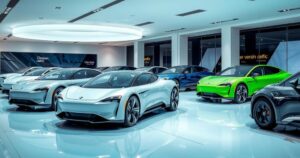BYD Surpasses Tesla in European EV Market, Marking a Shift in Industry Dynamics

In April 2025, BYD surpassed Tesla in European EV registrations, marking a pivotal moment for Chinese manufacturers. Despite Tesla’s long-standing dominance, BYD’s growth contrasts Tesla’s decline. Chinese automakers are expanding significantly, with over 15,000 units registered in April, even amid tariffs. Companies are also building factories overseas, paving the way for further global expansion.
In an important development for the automotive industry, Chinese automaker BYD made headlines by surpassing Tesla in pure electric vehicle registrations in Europe this past April. This shift marks a significant milestone for BYD, which posted a remarkable 169% increase in year-on-year registrations, contrasting distinctly with Tesla’s drop of 49%. Although BYD remains only the tenth-largest brand by overall registrations in Europe, this event symbolizes a broader transformation in the European auto market as Chinese new energy vehicle (NEV) manufacturers gain traction.
Tesla, renowned for being a primary player in the electric vehicle space, has been building its presence in Europe for over a decade. It has consistently ranked as the region’s most favored foreign electric vehicle brand. However, it now faces intensified competition from Chinese brands that have rapidly evolved over the years into significant contenders in this market.
China has successfully established a robust industrial ecosystem that encompasses vehicle manufacturing, battery research and development, and advanced intelligent driving systems. These advancements have empowered Chinese automakers to navigate the challenges posed by high tariffs, allowing them to capitalize on cost advantages and rapid product improvements to penetrate major international markets.
Data from Jato Dynamics reveals that, despite EU-imposed tariffs, electric vehicles manufactured by Chinese companies saw an impressive year-on-year registration increase of 59% in April, totaling nearly 15,300 units. This growth significantly outpaces the 26% growth rate experienced by European, Japanese, Korean, and American automakers. Furthermore, the China Association of Automobile Manufacturers reported that both production and sales of automobiles exceeded 10 million units in China during the first four months of 2025, with NEV exports climbing by 52.6% year-on-year to hit 642,000 units.
As 2025 unfolds, Chinese car brands are rapidly accelerating their global expansion efforts. BYD is entering the Swiss market, Xpeng is establishing roots in Bahrain, and IM Motors is launching its presence in Australia. Furthermore, manufacturers like Chery and SAIC are establishing their own shipping fleets, thereby strengthening their control over maritime logistics and supply chains.
Alongside these companies, the expansion of industrial capabilities abroad is keeping pace. Notably, Contemporary Amperex Technology Co. Limited (CATL), a leading Chinese EV battery manufacturer, is investing $1.2 billion in a new battery factory in Indonesia. Additionally, BYD’s inaugural vehicle plant in Hungary is on track for production commencement, while Great Wall Motors is hastening the development of a localized digital auto plant in Brazil.
With construction of overseas plants progressing, improved shipping capacities, and a thaw in global trade tensions, it appears that the future of Chinese auto exports is brightening. This substantial momentum creates promising opportunities for further growth in the international automotive landscape.
The rise of BYD in the European electric vehicle market illustrates the increasing influence of Chinese manufacturers. This breakthrough signals a shift in the landscape as these companies leverage their industrial advancements and cost advantages to expand overseas. With record exports and ambitious global strategies, Chinese car brands are set to continue their impressive growth trajectory in international markets.
Original Source: www.ecns.cn




